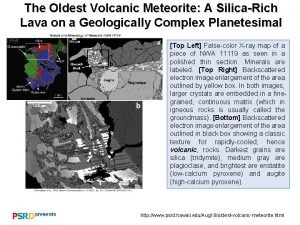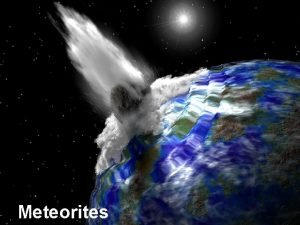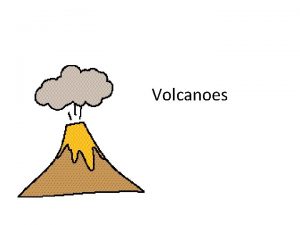The Oldest Volcanic Meteorite A SilicaRich Lava on
![The Oldest Volcanic Meteorite: A Silica-Rich Lava on a Geologically Complex Planetesimal [Top Left] The Oldest Volcanic Meteorite: A Silica-Rich Lava on a Geologically Complex Planetesimal [Top Left]](https://slidetodoc.com/presentation_image/2c29c8e082ad04f9805fd57c5415cc57/image-1.jpg)



- Slides: 4
![The Oldest Volcanic Meteorite A SilicaRich Lava on a Geologically Complex Planetesimal Top Left The Oldest Volcanic Meteorite: A Silica-Rich Lava on a Geologically Complex Planetesimal [Top Left]](https://slidetodoc.com/presentation_image/2c29c8e082ad04f9805fd57c5415cc57/image-1.jpg)
The Oldest Volcanic Meteorite: A Silica-Rich Lava on a Geologically Complex Planetesimal [Top Left] False-color X-ray map of a piece of NWA 11119 as seen in a polished thin section. Minerals are labeled. [Top Right] Backscattered electron image enlargement of the area outlined by yellow box. In both images, larger crystals are embedded in a finegrained, continuous matrix (which in igneous rocks is usually called the groundmass). [Bottom] Backscattered electron image enlargement of the area outlined in black box showing a classic texture for rapidly-cooled, hence volcanic, rocks. Darkest grains are silica (tridymite), medium gray are plagioclase, and brightest are enstatite (low-calcium pyroxene) and augite (high-calcium pyroxene). http: //www. psrd. hawaii. edu/Aug 18/oldest-volcanic-meteorite. html

Silicic Rocks Classification diagram for volcanic rocks. Andesite, dacite, and rhyolite are evolved compared to basalts. Blue dots show terrestrial continent range. ALM-A, NWA 7325, and NWA 11119 are related to each other by O isotopes. http: //www. psrd. hawaii. edu/Aug 18/oldest-volcanic-meteorite. html

Oxygen Isotopes Point to Kinship with Ureilites Oxygen isotope plot for evolved igneous rocks in meteorites, ureilites, ALM-A, and three other types of meteorites whose parent bodies experienced enough heating to melt at least partially. TFL is the terrestrial fractionation line. CCAM shows where anhydrous components in carbonaceous chondrites plot. The clear correspondence of NWA 11119, ALM-A, NWA 7325, and ureilites suggests that they might all be from the same parent asteroid. http: //www. psrd. hawaii. edu/Aug 18/oldest-volcanic-meteorite. html

Surprisingly Early Silicic Volcanism The age of silicic volcanic rock NWA 11119 is 4564. 8 ± 0. 3 million years, only 2. 5 -3. 5 million years younger than Calcium. Aluminum-Rich inclusions, the first solids to form in the Solar System. Implication: in 2. 5 to 3. 5 million years, the parent body of NWA 11119 accreted, probably with a roughly chondritic composition, and began to melt, in some places melting was the right amount to form silicic magma, which erupted onto the surface. http: //www. psrd. hawaii. edu/Aug 18/oldest-volcanic-meteorite. html







